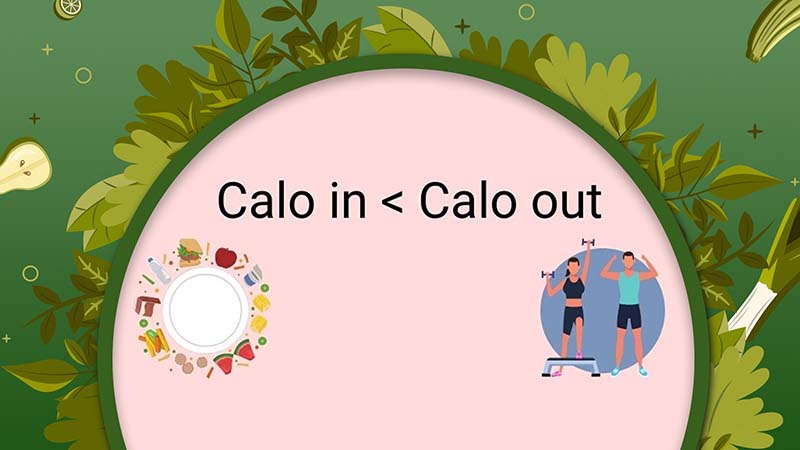Diet & Weight Loss
Understanding What Is a Calorie Deficit for Weight Loss
One of the key principles for effective weight loss is maintaining a calorie deficit. However, not everyone knows how to eat in a calorie deficit correctly and maintain an appropriate calorie level for safe weight loss while ensuring good health. Let’s Scham-online.de explore what a calorie deficit is and how to eat in a calorie deficit for weight loss through the following article!

1. What Is a Calorie Deficit? The Importance of Calorie Deficit in Weight Loss
Calories are units of energy that we get from food, helping to sustain life functions and provide energy for daily physical activities.
Carbohydrates, fats, and proteins are nutrient sources with calories, providing the main energy for the body. However, excess calories consumed will be converted and stored in the body as fat.
A calorie deficit occurs when the total calories consumed in a day are less than the energy burned through activities and exercise. Therefore, it is considered an effective weight loss method, helping the body burn excess energy when a calorie deficit is maintained consistently.

2. How to Calculate a Calorie Deficit
The principle of weight loss based on a calorie deficit is straightforward: If you eat more than you burn, you will gain weight. Conversely, weight will decrease if you consume fewer calories than you burn through physical activity.

To calculate a calorie deficit, you need to determine your calorie intake (BMR) and the calories burned in a day (TDEE) using the following formulas:
Step 1: Calculate BMR (Basal Metabolic Rate)
BMR is the number of calories needed to maintain basic life-sustaining activities such as breathing, maintaining blood pressure, and digestion. Here, we use the Mifflin-St Jeor Equation:
- Men: BMR = 10W + 6.25H – 5A + 5
- Women: BMR = 10W + 6.25H – 5A – 161
Note:
- W is body weight in kg
- H is height in cm
- A is age
Step 2: Calculate TDEE (Total Daily Energy Expenditure)
TDEE is the total number of calories you burn in a day, based on the formula:
- TDEE = BMR x Activity Factor
Activity Factors:
- TDEE = BMR x 1.2 if you are sedentary or do not exercise
- TDEE = BMR x 1.375 if you exercise lightly 1-3 days/week
- TDEE = BMR x 1.55 if you exercise moderately 3-5 days/week
- TDEE = BMR x 1.725 if you engage in heavy exercise 6-7 days/week
- TDEE = BMR x 1.9 if you exercise intensely twice a day
You can calculate BMR and TDEE by entering your information on online calculators or tools available on websites like HelloBacsi.
Step 3: Calculate the Calorie Deficit
Calorie Deficit = TDEE – BMR
According to the American Heart Association, you can lose 0.45 kg (1 lb) in a week if you eat 500 calories less than your daily maintenance calories.
For example: If your TDEE (calories burned) is 2,000 calories a day and your intake is 1,500 calories (a calorie deficit of 2,000 – 1,500 = 500 calories); consistently maintaining these figures for 7 days, you will lose 0.45 kg (1 lb).
You can lose weight faster by increasing the intensity and duration of your workouts to burn more calories.
3. Safe Calorie Deficit Levels Recommended by Experts
Experts recommend starting with a calorie deficit of 200-300 calories and gradually increasing to 500-750 calories to allow the body to adapt gradually.

Additionally, it’s essential to ensure adequate calorie intake for energy and safe weight loss:
- Women should aim for 1,200 to 1,500 calories per day for safe weight loss.
- Men should aim for 1,500 to 1,800 calories per day for safe weight loss.
- Overweight or obese adults should reduce total calorie intake by adopting various eating styles over 6 months to 2 years.
4. Who Should Not Follow a Calorie Deficit Diet
While the benefits of a calorie deficit in weight loss are undeniable, some individuals with certain health conditions should not follow this diet without consulting a specialist:
- People with type 2 diabetes: A lack of calories can lead to dangerously low blood sugar levels.
- Kidney problems: Changes in water intake during calorie reduction can strain the kidneys.
- High or low blood pressure: Hydration changes and reduced water intake can affect blood pressure.
Individuals with these health issues should consult with medical professionals before adopting a calorie deficit diet.

5. How to Achieve a Calorie Deficit
5.1 Reduce Calorie Intake
- To control food intake, you can apply the following calorie deficit eating tips:
- Divide meals: Eat smaller, more frequent meals throughout the day. If still hungry, add vegetables or fruits.
- Eat fruits and vegetables: Experts recommend consuming fruits and vegetables daily, as their water and fiber content helps you feel full longer.
- Use smaller plates: Smaller plates help you control portion sizes and food intake.
- Check food labels: Some foods have nutritional information, allowing you to monitor portion sizes and calorie content.
- Use calorie counting tools: Utilize mobile apps or reliable websites to track your intake.
Besides following a calorie deficit diet, ensure you drink enough water, consume sufficient protein to maintain muscle mass, and take multivitamins to prevent nutrient deficiencies during the initial stages.
5.2 Physical Activity
Choose 1-2 sports to follow and maintain as a habit or personal interest. Effective calorie-burning activities include:
- Swimming
- Gym workouts
- Running
- Cycling
- Hiking
- Various sports
6. Why a Calorie Deficit Might Not Result in Weight Loss
Several factors can affect metabolism, preventing weight loss despite a calorie deficit, such as:
- Medications: Weight gain medications, hormonal contraceptives, antidepressants, antipsychotics, and insulin for diabetes.
- Lack of sleep: Disrupted sleep affects cortisol levels and metabolism. Sleep apnea also impacts sleep quality and weight loss.
- Stress: Prolonged stress affects cortisol levels, hindering weight loss.
- Menopause: Hormonal changes disrupt body chemistry, affecting metabolism.
- Other health issues: Conditions like polycystic ovary syndrome (PCOS) and metabolic syndrome impact metabolism, making weight loss difficult.

7. Dietary Tips When Aiming for a Calorie Deficit
7.1 Eating Less to Speed Up Weight Loss?
The answer is no. A significant calorie deficit in a short time can have adverse effects, causing:
- Fatigue
- Nausea
- Dehydration
- Constipation
- Headaches
- Food cravings
Even if you force a 500-calorie deficit, your body will need time to adjust and adapt.
7.2 How Many Calories to Deficit to Lose 1kg?
As mentioned, maintaining a 500-calorie deficit daily for 7 days results in a 0.45 kg (1 lb) weight loss, equivalent to 3,500 calories. Therefore, to lose 1 kg, you need a deficit of 7,000 calories over 2 weeks.

7.3 Avoid Cutting Too Much Protein
The body struggles to maintain muscle mass if protein intake is cut while achieving a calorie deficit. Protein builds muscle and is crucial for maintaining metabolism. A slow metabolism leads to calories being stored as fat.
Therefore, maintain a moderate calorie deficit to utilize stored fat while preventing muscle loss.
7.4 Don’t Cut Too Many Calories
A large calorie deficit over a short time leads to increased hunger, causing overeating and potential weight gain. Initially, cut a small number of calories to avoid excessive hunger, then gradually increase the deficit as desired.
We hope this information helps you understand the principle of calorie deficit for safe and effective weight loss.
